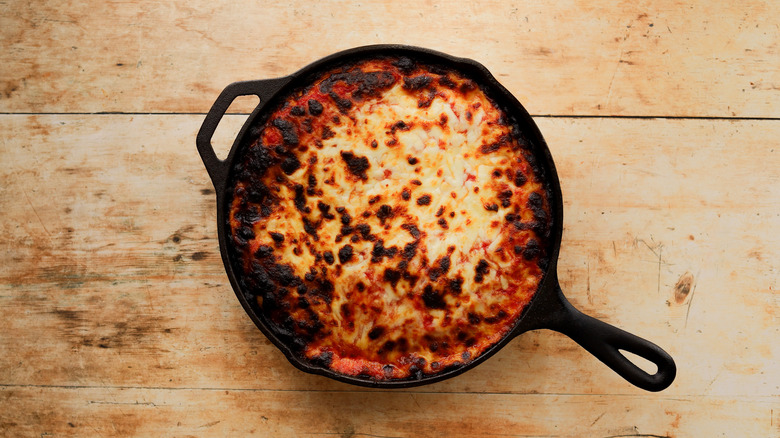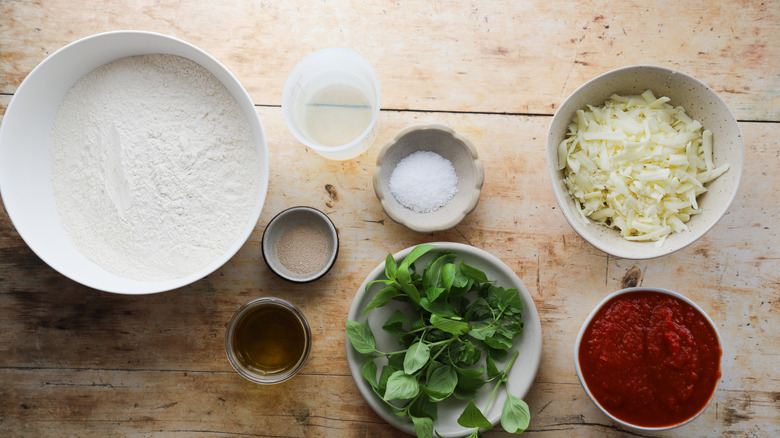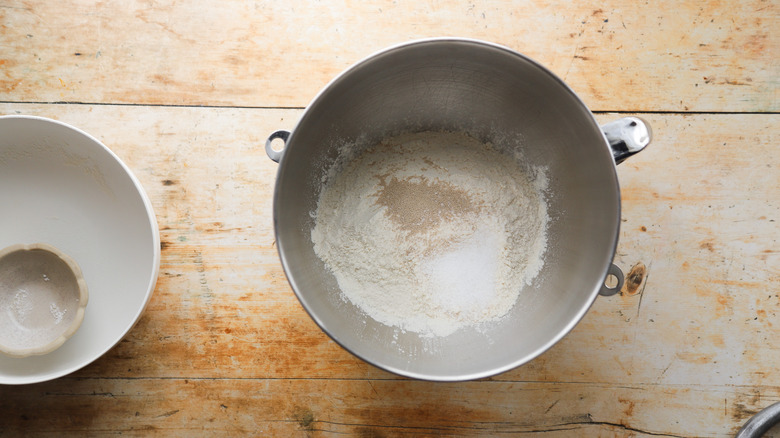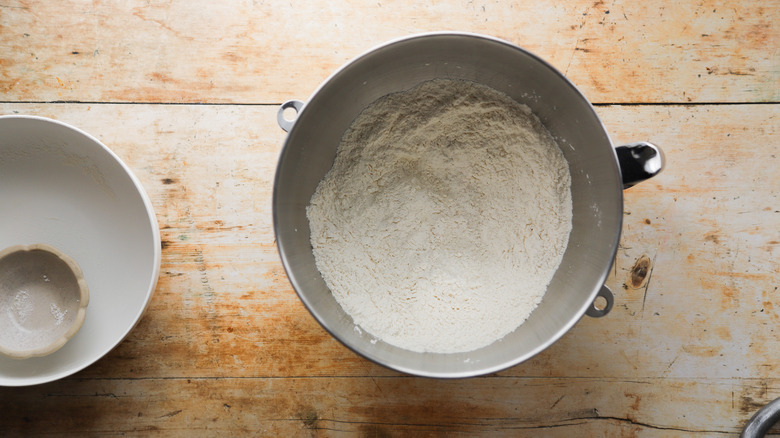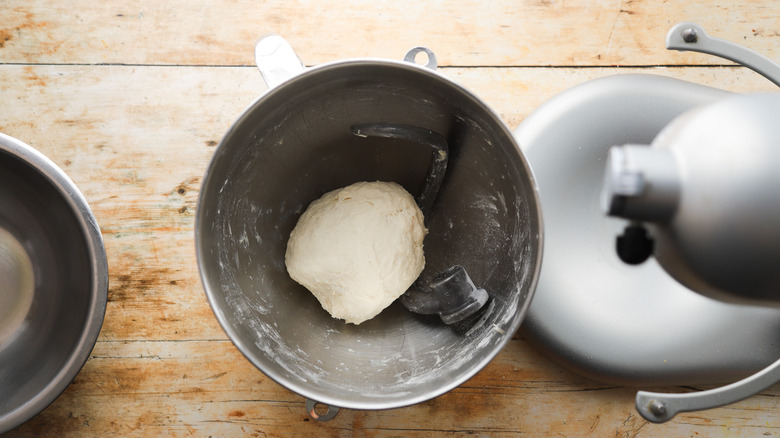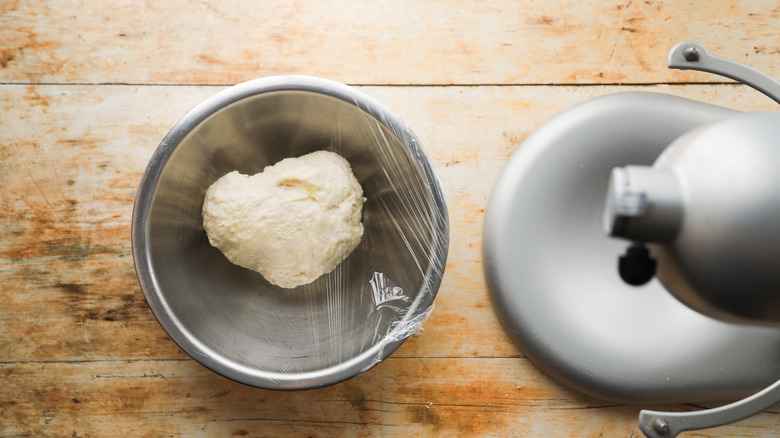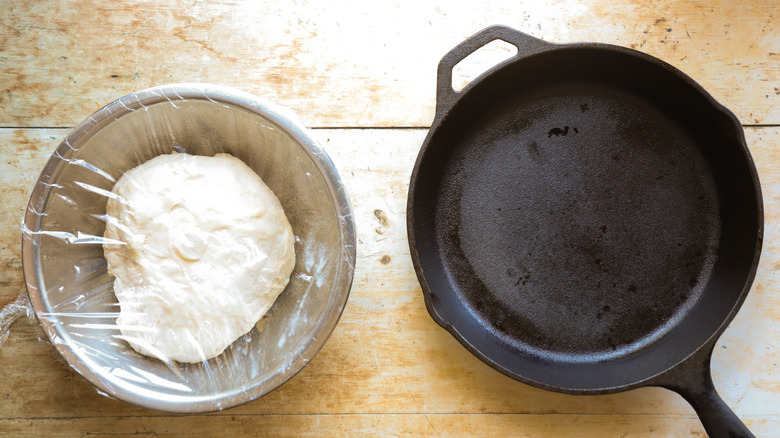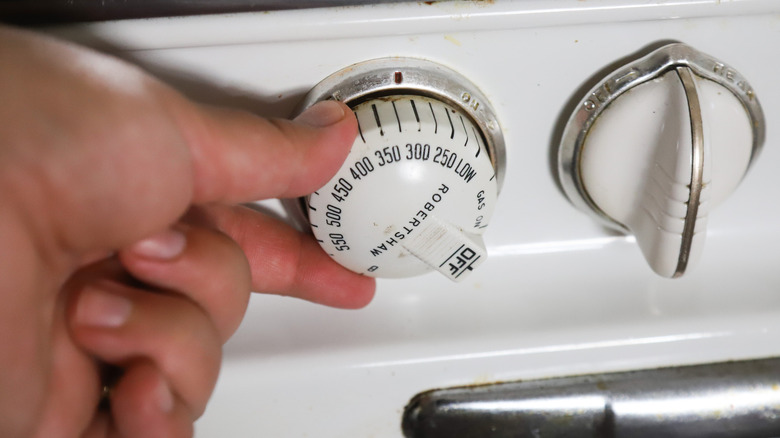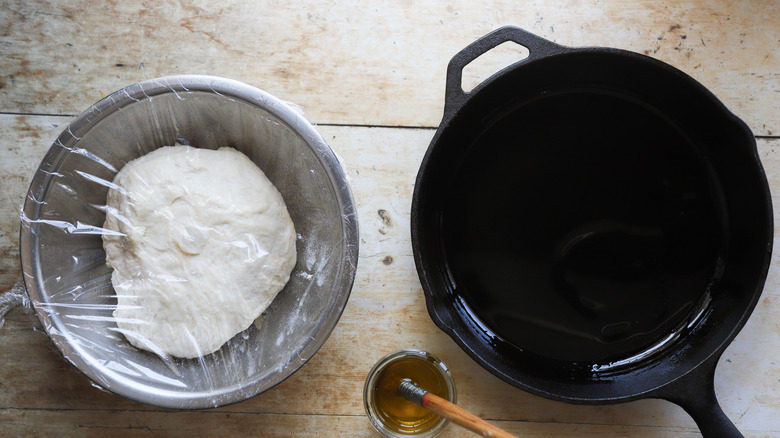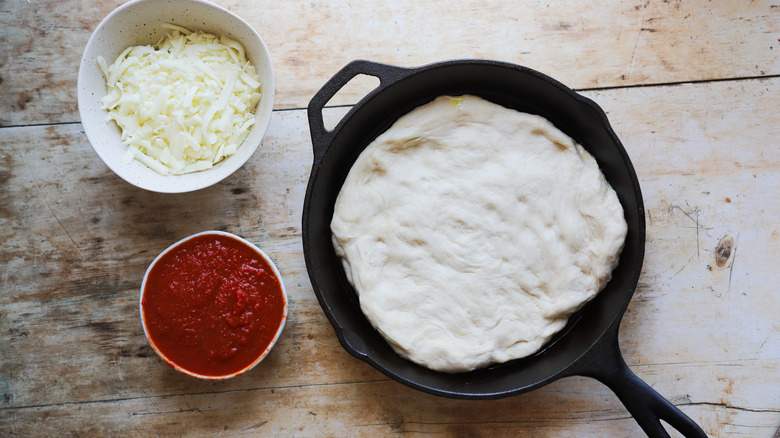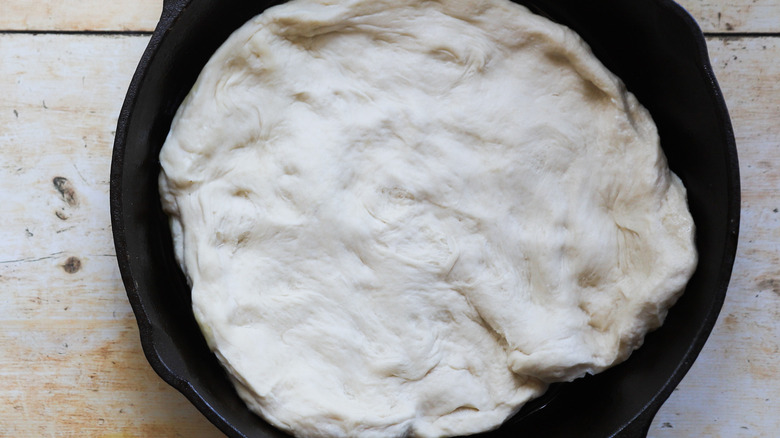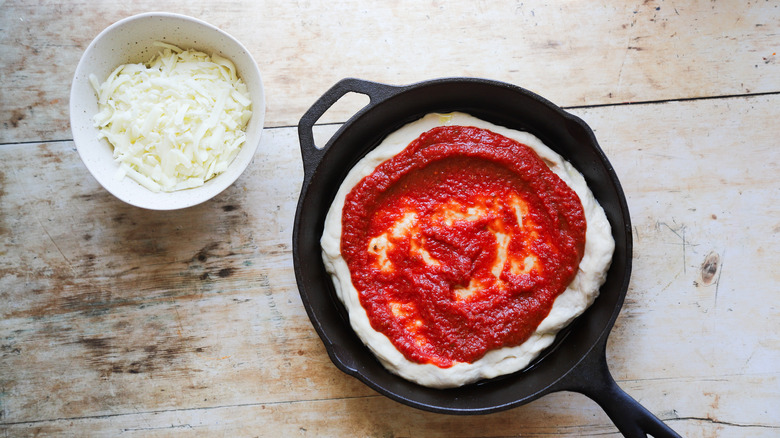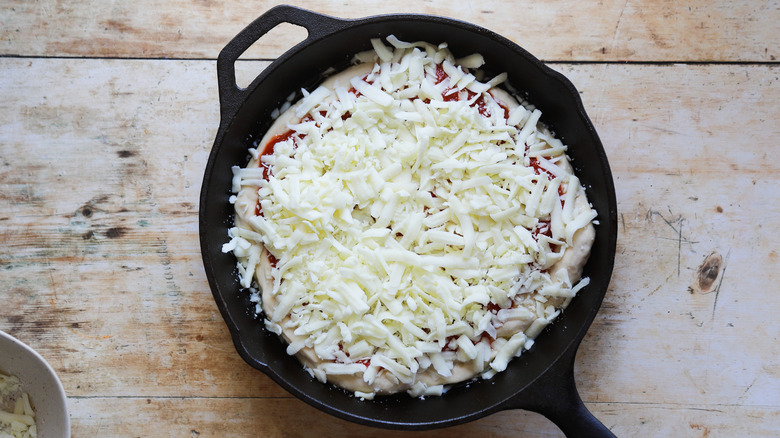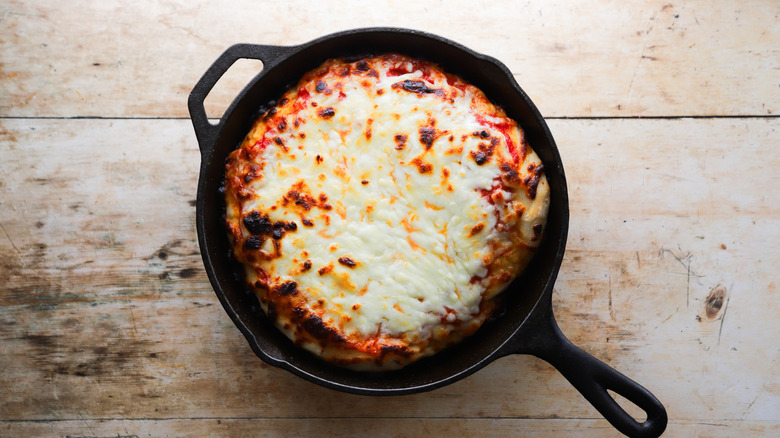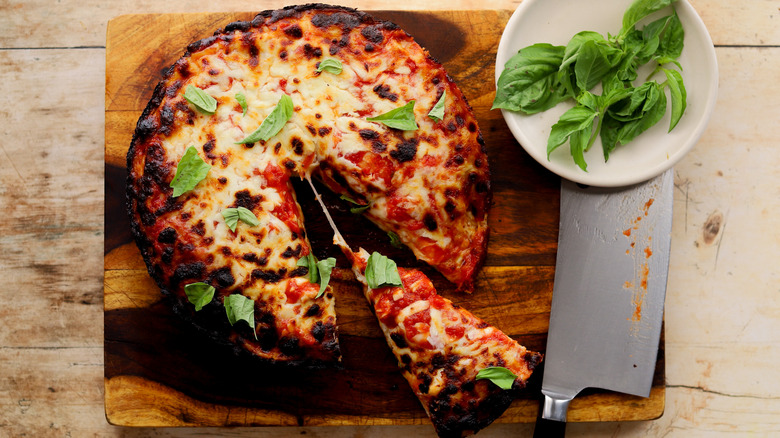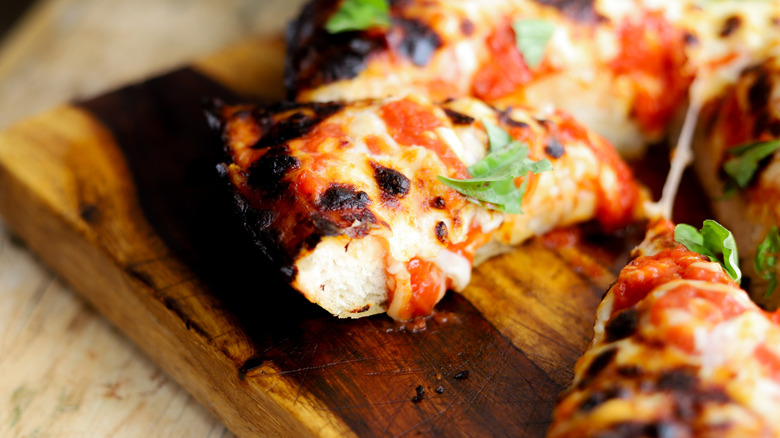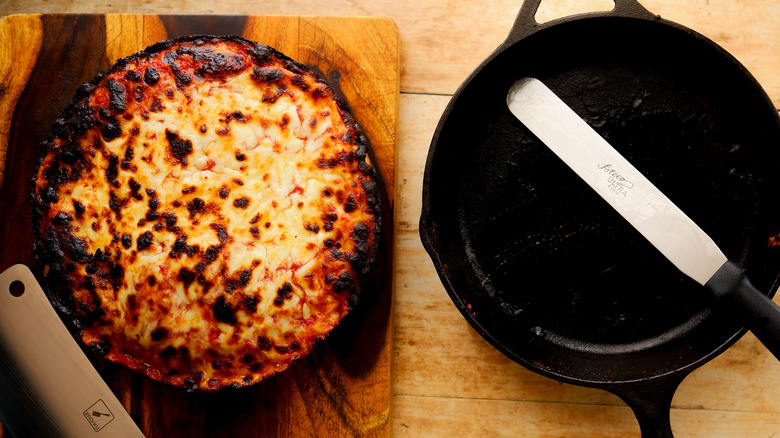Crispy No-Knead Skillet Pizza Recipe
Thin-crust pizzas have their appeal, but there's something about a thick, crispy pan pizza with cheesy burnt edges that just satisfies in a different way. For one, this type of pizza doesn't have to be rolled or stretched. Typically made using a focaccia-like dough, this tender fluffy pizza crust starts with a no-knead dough recipe that proofs overnight in the refrigerator. After letting it sit in a well-oiled cast iron pan while it comes to room temperature, it will become light, airy, and ready to top.
Whether you're a seasoned pizza maker or you're dying to make pizza at home but feel a bit intimidated by the idea of dough-making or of transferring the dough to a pizza stone in a wicked-hot oven, this recipe will be perfect for you. The pizza slides into the oven in a cast iron pan with practically no risk of user error. Recipe developer Taylor Murray brings us a crispy, crusty pan pizza topped with plenty of tomato sauce, mozzarella cheese, and fresh basil.
Gather the ingredients for no-knead skillet pizza
One of the great things about pizza dough is the simplicity of its ingredients. The dough for this recipe can be made with just bread flour, kosher salt, dry active yeast, and some water. Bread flour has more structure for a better chew, but you could ultimately swap that for all-purpose flour as long as you decrease the water added. To bake the pizza, we'll oil the pan generously, so make sure you have some olive oil on hand. To top the pizza, we'll use a standard pizza sauce, either store-bought or homemade, and shredded mozzarella. Finish the pizza with torn fresh basil.
Step 1: Combine the dry ingredients
Combine the flour, salt, and yeast in the bowl of a stand mixer fitted with dough hook attachment.
Step 2: Stir
Stir quickly to combine.
Step 3: Add water
Add water and mix on low speed until the dough comes together to a ball.
Step 4: Proof in refrigerator
Remove to an oiled bowl, cover tightly with plastic wrap, and refrigerate for at least 24 hours and up to 36.
Step 5: Proof at room temperature
Remove the dough from the refrigerator and set it in a warm place to rise until doubled in volume, about 2 hours.
Step 6: Heat the oven
Heat the oven to 500 F.
Step 7: Oil the skillet
Coat the bottom and sides of a cast iron skillet with oil.
Step 8: Transfer the dough to the pan
Transfer the dough to the pan and stretch to the edges, using your fingers to push the dough outwards till the pan is covered.
Step 9: Rest again
Let the dough rest in the pan for 30 minutes. If the dough has shrunk from the edges, spread once more.
Step 10: Add the sauce
Top the dough with pizza sauce.
Step 11: Add the cheese
Sprinkle the cheese over the sauce.
Step 12: Bake the pizza
Transfer to the oven and bake until the dough is risen and the edges are crisp, about 15 minutes. Let cool.
Step 13: Finish the pie
Remove from the pan and top with basil before serving.
Crispy No-Knead Skillet Pizza Recipe
With no kneading, rolling, or stretching, you can make a tender, fluffy, saucy, cheesy thick-crust skillet pizza ready for all of your favorite toppings.
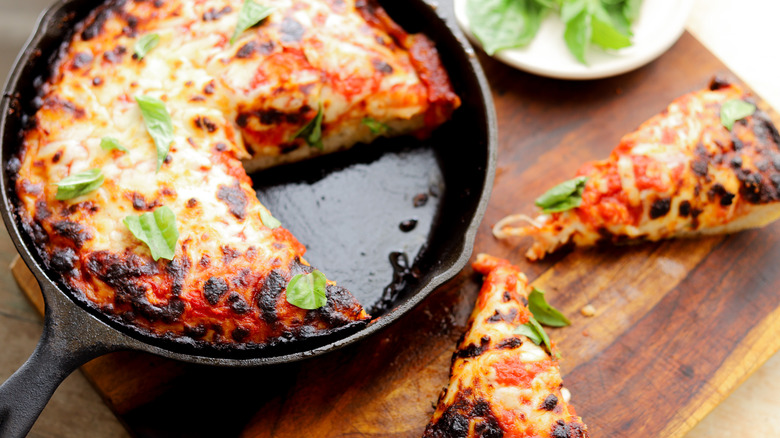
Ingredients
- 2 cups bread flour
- 1 tablespoon kosher salt
- 1 teaspoon dry active yeast
- 1 ¼ cups tepid water (about 100 F)
- ¾ cups pizza sauce
- 1 ½ cups shredded mozzarella cheese
- ⅓ cup basil leaves
Directions
- Combine the flour, salt, and yeast in the bowl of a stand mixer fitted with dough hook attachment.
- Stir quickly to combine.
- Add water and mix on low speed until the dough comes together to a ball.
- Remove to an oiled bowl, cover tightly with plastic wrap, and refrigerate for at least 24 hours and up to 36.
- Remove the dough from the refrigerator and set it in a warm place to rise until doubled in volume, about 2 hours.
- Heat the oven to 500 F.
- Coat the bottom and sides of a cast iron skillet with oil.
- Transfer the dough to the pan and stretch to the edges, using your fingers to push the dough outwards till the pan is covered.
- Let the dough rest in the pan for 30 minutes. If the dough has shrunk from the edges, spread once more.
- Top the dough with pizza sauce.
- Sprinkle the cheese over the sauce.
- Transfer to the oven and bake until the dough is risen and the edges are crisp, about 15 minutes. Let cool.
- Remove from the pan and top with basil before serving.
Nutrition
| Calories per Serving | 391 |
| Total Fat | 17.2 g |
| Saturated Fat | 10.4 g |
| Trans Fat | 0.0 g |
| Cholesterol | 57.8 mg |
| Total Carbohydrates | 37.8 g |
| Dietary Fiber | 1.9 g |
| Total Sugars | 2.0 g |
| Sodium | 574.2 mg |
| Protein | 20.5 g |
Can I make a skillet pizza without a cast iron skillet?
Despite the name, you can make skillet pizza without a skillet. In this case, the pizza would be more of a pan pizza. To replicate the round edges, you could use a dark metal cake pan. Simply follow the remaining instructions as needed, noting that not as much heat will be conducted through the metal so you may not get quite as crisp of a crust. You can always bake it for a bit longer, covering the top with foil so the cheese doesn't burn while you darken the crust a bit.
If you don't need the edges to corral your dough, you can also make a pan pizza on a rimmed baking sheet or a 9-by-13-inch baking pan. Make sure to oil the pan just the same as you did the cast iron skillet and you should end up with a delicious crispy, tender, cheesy pie.
What are some alternative ways I can top a skillet pizza?
If you are a pizza-lover, then you probably already know how you like your pizza topped. While this recipe suggests a simple topping of tomato sauce, mozzarella cheese, and basil, there are so many other ways you could take it. Any traditional pizza topping, from pineapple and ham to sliced peppers and sausage could be added on to this recipe. Pepperoni, mushrooms, garlic, or even anchovies are all fair game for this skillet pizza. Grilled or breaded and fried eggplant also makes a great addition to this sturdy pizza, as would meatballs or sausage.
If you want to take it in a totally different direction, you could swap out the tomato sauce for a barbecue sauce or a light green pesto. You'll still want to make sure there is plenty of mozzarella cheese, though you could add a grating of a hard cheese such as Romano or Pecorino for a different flavor profile. Finish it with chili oil, hot honey, balsamic reduction, or a drizzle of olive oil. You could also add flavor with extra herbs either before or after baking, such as oregano or rosemary. Add a little kick of heat with chile flakes or Aleppo pepper flakes.
